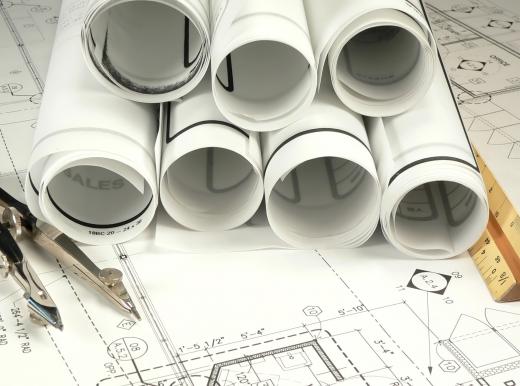What is an Engineering Scale?
An engineering scale, also known as an engineer’s scale, is actually a type of ruler that produces ratio drawings. Engineers typically use this scale for drafting and blueprint creation. For example, with an engineering scale it is possible to manually create a drawing that is ten times larger or ten times smaller than the original that the engineer is drawing from.
In the United States and Canada, a conventional engineer’s scale looks somewhat like a three-sided ruler and is usually made of plastic. People sometimes confuse an engineer’s scale with a normal ruler and may use it in this capacity. Each wing of the engineering scale is marked on both sides, which gives it six measuring surfaces. Although similar in appearance to an architect’s scale, the engineering scale is designed to be more precise and is able to take smaller measurements.

In North America, the six edges of the engineering scale are marked with progressively smaller measuring units. The largest is 1/10 inch (2.54 mm), followed by 1/20, 1/30, and so on all the way down to 1/60 of an inch (.4 mm) on the final side. Its delicate measurements allow engineers to use these scales for creating circuit boards and electronics parts.
Engineering scales are commonly 300 mm long, which is a little more than 12 inches. The extra space on the ends is meant to provide a safety margin. If the scale is exposed to wear and tear, its end notches will still be visible.

Knowing how to read the scale’s ratio is often key in using it. Typically, an engineering scale will have a listed ratio like 1:10 or 1:5 which means that the scale can render a drawing that is one tenth or one fifth of the original size, respectively. In some cases, modern Computer Aided Design (CAD) drafting technology has replaced the conventional engineering scale. CAD is an electronic process whereby the engineer can quickly and easily create a blueprint in 2D or 3D and change its measurements and proportions.
CAD has revolutionized the engineering world and made hand-drawing with an engineer’s scale virtually obsolete in some areas. An engineering scale can still be useful in situations where CAD drafting is either not possible or not desired, however, such as when there is no computer access. Learning how to draw by hand with an engineering scale is often considered a good foundational exercise for later CAD drafting.
AS FEATURED ON:
AS FEATURED ON:












Discuss this Article
Post your comments